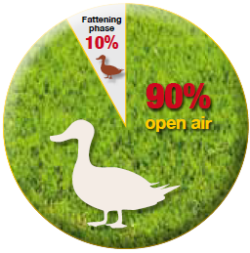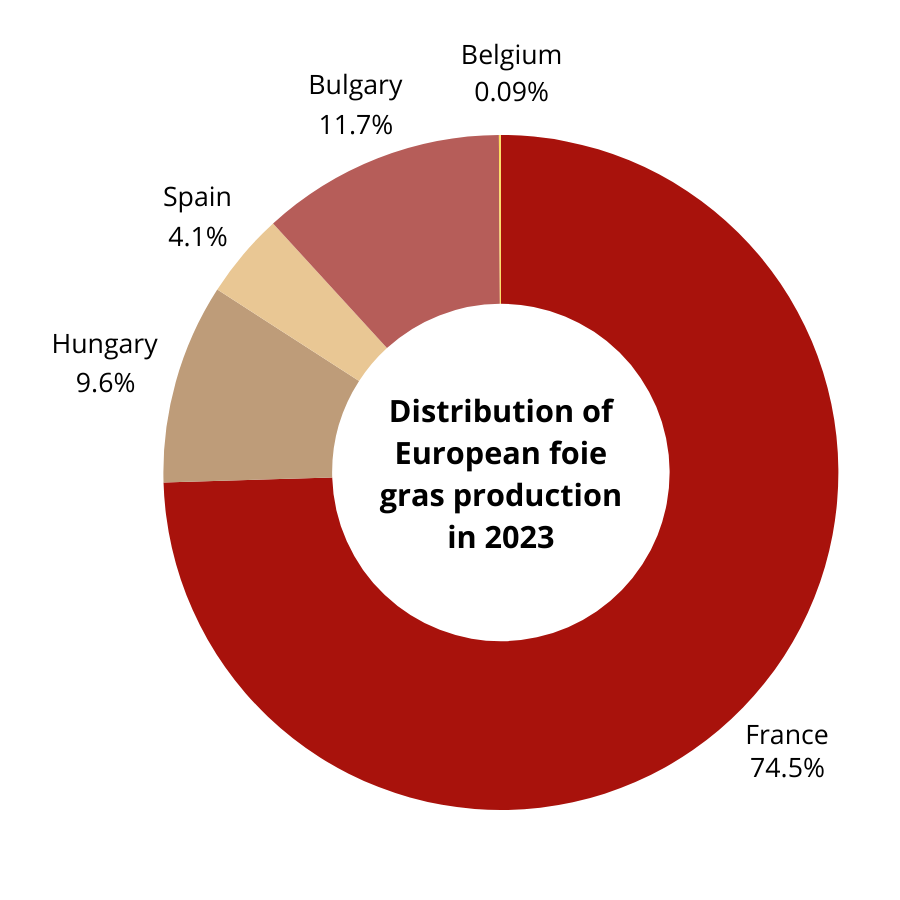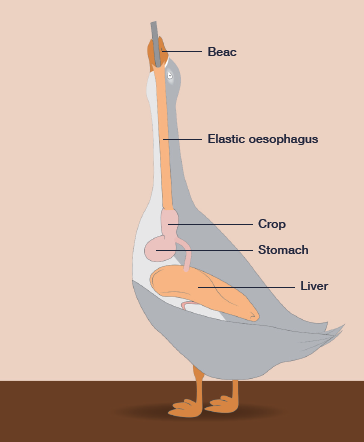The steps
The production of foie gras in the European Union is extensive, outdoor and often family.
In addition, a foie gras is necessarily the healthy liver of an adult duck or goose, robust and healthy, raised according to tradition, but also and above all according to the regulations in force. The foie gras must come from geese or ducks fattened in such a way as to reach a minimum weight of 400 gr for goose foie gras and 300 gr for duck foie gras and it should be noted that only selected breeds or lines of palmipeds are able to produce foie gras. For example, for duck foie gras: Muscovy duck (Cairina moschata) and Mulard duck (Cairina moschata x Anas platyrhynchos).
In the EU, the breeding method for the production of foie gras is divided in two successive phases :

1. The rearing phase
This period extends from hatching to the end of palmiped growth and concerns the most part of the breeding cycle, i.e. 10 to 15 weeks depending on the species. This phase takes place with systematic access of waterfowl to an outdoor course.
With 90% of the life of the animal spent outdoors, open air is a fundamental characteristic of the breeding of foie gras palmipeds. Breeders are proud of this particularity that they want to maintain despite the risks, requirements and necessary adaptations that this entails (tools to avoid possible attacks by predators, strict biosecurity measures aimed at preventing and controlling health risks such as avian influenza, etc.).
2. The fattening phase
It intervenes at the end of breeding and extends over a period of 10 to 16 days depending on the species. The palmipeds have particular anatomical characteristics (possible alignment of the beak and neck thanks to the absence of cartilaginous glottis, elasticity of the walls of the esophagus…) which allow them to swallow large preys such as fish or frogs and predispose them to the fattening phase during the production of foie gras. Consequently, fat palmipeds have a very different anatomy and cannot therefore be compared to humans. In order to prepare the animals for fattening, a transition phase makes it possible to accustom the animal to feed by meal, thus developing its ability to fatten.
What is assisted feeding?
Once prepared, adult animals are placed in specialized facilities for fattening. Assisted feeding consists of feeding them with know-how and dexterity by qualified professionals.
Palmipeds are big eaters. At certain times they become bulimic.
Only a healthy adult duck or goose (10 to 15 weeks old), after an ad-libitum feeding period, will receive twice every 24 hours, for about 12 days for ducks, 16 days for geese, a progressive ration which consists of filling the crop. Various scientific studies have shown that assisted feeding does not stress the palmiped who gradually gets used to receiving the food that gives him the state of satiety. This phase represents 10% of the breeding time of the animal.
The fatty liver is a healthy organ: after fattening, when a duck or a goose is put back in its meadow, its liver regains its initial weight in a few days, without modifying its physiological functions. This reversibility of fattening is identical to what occurs naturally when a bird has exhausted its fat reserves after a long migratory journey.
The figures

- 13,571 tonnes of foie gras were produced within the EU in 2023 (12,761 tonnes of duck foie gras and 810 tonnes of goose foie gras)
- The sector generates more than 50 000 direct jobs in the EU.
- The EU produces approximately 80% of the world’s foie gras. The other main producing countries are China, the United States and Canada.
- According to Eurostat, intra-community trade amounted to 242 million euros in 2023.
- According to Eurostat in 2023, EU exports of foie gras to third countries amounted to 75 million euros.

